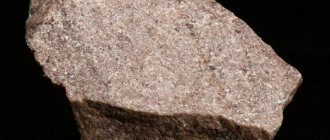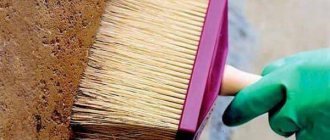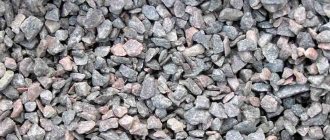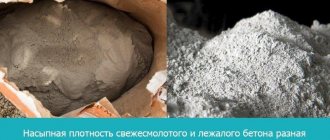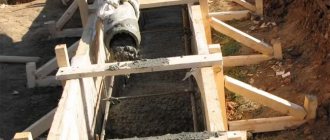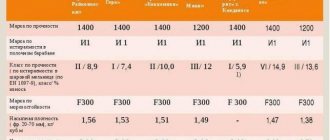Depending on the intended purpose of the solution, calculate how much crushed stone to add to 1 m³ of concrete. The reasons for adding crushed stone to concrete are to reduce cost and increase the strength of the finished mixture.
Granite or diabase stone enhances frost resistance and resistance to compressive loads. Its volume is determined depending on the brand of concrete being prepared, for example, m200 or m500, with different ratios and weights of the components.
Crushed stone is produced by crushing solid rock from granite, limestone, gravel, diabase or other rocks. Light stones are mined: tuff, limestone. Slag from blast furnaces and open-hearth furnaces and construction waste are also added to the solutions. When grinding, different fractions and flakiness are obtained. After grinding, they are calibrated through a sieve with different mesh sizes, dividing them by size.
RECOMMENDED ON THE TOPIC
- How much money does...
- How long does it take for concrete to gain strength?
Standard stone sizes:
- 70-20 mm – for pouring a monolith;
- 70-40 mm – for massive reinforced concrete structures;
- 60-25 mm – for railways;
- 40-20 mm – mortar for foundations for heavy industrial buildings;
- 20-10 mm - placed in concrete for pouring the foundation for a house, building a roadway;
- 10-5 mm – for the production of floor slabs;
- Gran screening – for casting concrete decor with a washed surface effect.
The shape of the grain is of great importance. The cuboid shape is considered the best, as it provides reliable adhesion inside the solution. Round gravel will weaken the strength of the mortar, while sharp or needle-shaped gravel will make the surface rough. Ideally, cube-shaped grain is used with the partial addition of needle-shaped or flat-flaky crushed stone.
Step-by-step instructions for making concrete by hand
Nowadays, concrete mixers are most often used for concreting. But not all developers yet work with technology, especially if they need to quickly prepare a small amount of concrete for urgent repairs. The mass is stirred with a shovel or hoe in a special trough. If you don’t have it, then you can make concrete on a hard, level area; large sheets of thick iron are often used for this purpose. Mixing is much simpler and easier with a hoe; attach a long handle to it so that you can reach from one place throughout the entire trough.
Trough and hoe for mixing concrete manually
Step 1. Fill a container with dry cement, pour in water and mix everything very thoroughly. Your task is to turn the composition into the consistency of milk. A bucket of cement requires about half a bucket of water. Below we will describe in detail what causes this proportion.
Cement is poured into a dry trough, then water is poured in.
Step 2. Mix the composition thoroughly with a hoe.
Cement and water must be mixed until the lumps dissolve
In such a container you can prepare a composition from one bucket of cement, three buckets of sand and the same amount of crushed stone. There is no need to do more at one time - it is very difficult to mix increased volumes of concrete. It's much easier to make two small batches than one big one. In addition, the quality is also much better, the positive effect is achieved through more thorough mixing.
Step 3. Pour crushed stone into the trough. It will completely break up the remaining small lumps of cement. You can pour all three buckets of material at once; it is advisable to distribute it evenly over the entire area of the container.
Crushed stone can be added immediately in full
Step 4: Start mixing. This is already somewhat more difficult than working with cement alone.
Stirring with crushed stone will require more physical effort
Step 5. Add three buckets of sand to the container. In our case, sand and crushed stone are poured into bags, each containing three buckets, as required by the recipe. Mix the sand, this is the most difficult operation and requires quite a lot of effort and time. The hoe should slide along the bottom of the trough and across the entire area.
After adding sand, you need to stir very thoroughly.
Depending on the actual consistency, add water or sand; we have already described how this is done and what you need to pay attention to. Prepare as much mixture as you can use within thirty minutes
After this time, the rates of chemical reactions of cement critically increase. Concrete hardens; adding water to it is strictly not recommended; as a result of such actions, the material significantly worsens its strength parameters.
Ready concrete must be used within half an hour
Fillers - crushed stone and sand
The composition of concrete is determined by the functions and characteristics of concrete that are necessary during its operation. The most common are sand and crushed stone. They are subject to no less stringent requirements than the quality of cement. Sometimes pebbles are used, but only if they have sharp edges and not round ones. In the presence of broken lines, the adhesion of the aggregate to the solution is better, as a result, the strength of the concrete is much higher.
Sand
Construction sand can be river or quarry sand. River water is more expensive, but it is usually cleaner and has a more uniform structure. It is best used when preparing concrete for pouring foundations and screeds. For masonry or plastering, it is appropriate to use cheaper quarry sand.
In addition to its origin, sand is distinguished by fractions. For construction work, large or medium ones are used. Small and dusty ones are not suitable. The normal size of sand grains is from 1.5 mm to 5 mm. But optimally in solution it should be more homogeneous, with a difference in grain size of 1-2 mm.
The sand must be clean, preferably with the same grain sizes
The cleanliness of the sand is also important. It should definitely not contain any foreign organic inclusions - roots, stones, pieces of clay, etc. Even the dust content is standardized. For example, when mixing concrete for a foundation, the amount of contamination should not exceed 5%. This is determined empirically. 300 ml of sand is poured into a half-liter container, everything is filled with water. After a minute, when the grains of sand settle, the water is drained and refilled. This is repeated until it is transparent. After this, determine how much sand is left. If the difference is no more than 5%, the sand is clean and can be used when mixing concrete for the foundation.
For those jobs where the presence of clay or lime is only a plus - when laying or plastering - there is no need to take special care of the cleanliness of the sand. There should be no organic matter or stones, and the presence of clay or lime dust will only make the solution more plastic.
Crushed stone
For critical structures - floors and foundations - crushed crushed stone is used. It has sharp edges that adhere better to the mortar, giving the structure greater strength.
Crushed stone fractions are standard:
- extra small 3-10 mm;
- small 10-12 mm;
- average 20-40 mm;
- large 40-70 mm.
In the batch, crushed stone is used in several fractions - from small to coarse
Several different fractions are used simultaneously in concrete. The largest fragment should not exceed 1/3 the size of the smallest element of the structure being poured. Let me explain. If a reinforced foundation is being poured, then the structural element that is taken into account is the reinforcement. Find the two elements closest to each other. The largest stone should not be more than 1/3 of this distance. In the case of pouring a blind area, the smallest size is the thickness of the concrete layer. Choose crushed stone so that it is no more than a third of its thickness.
Fine crushed stone should be about 30%. The remaining volume is divided between medium and large in arbitrary proportions
Pay attention to the dustiness of the crushed stone. Lime dust is especially undesirable
If there is a lot of it, the crushed stone is washed, then dried, and only then poured into concrete.
Aggregate storage
It is clear that a construction site is not the cleanest and most organized place, and sand and crushed stone are often dumped directly onto the ground. In this case, when loading, you must ensure that no soil gets into the mix. Even a small amount will negatively affect the quality. Therefore, it is advisable to pour aggregates onto solid areas.
It is also necessary to protect them from precipitation. In concrete formulations, the number of components is given based on dry components. You learn to take into account the moisture content of components with experience. If you don’t have one, you have to take care of the condition and cover the sand and gravel from rain and dew.
Calculation of concrete mixture composition
The classification of concrete is based on compressive strength. In accordance with the requirements of SNiP2.03.01-84 “Concrete and reinforced concrete structures”, the marking of concrete on concrete structures, as well as from a mixture of sand and crushed stone, contains the letter “B” and numbers indicating the load in MPa. This is a relatively new designation.
The more familiar marking with the letter “M” and strength, measured in kg/cm2, has not lost its relevance. By the way, cement is marked in exactly the same way. Concrete grades from M100 to M 500 are used in construction.
The strength, density and other characteristics of the final product are affected by the ratio of cement and the proportion of PGS in concrete, as well as the content of aggregates made from grains of different sizes in the mixture. The following grades of concrete are used for certain purposes:
- M 150 – it is recommended to prepare for the construction of foundations for light buildings of one floor;
- M 200 – used in the construction of strip and low-power slab foundations;
- M 250 – for foundations in the form of a monolithic slab for medium loads;
- M 300 – for monolithic foundations of any design;
- M 400 - with high-quality cement, used for the construction of especially powerful foundations under heavy loads.
For the convenience of calculating material consumption, we will combine the proportions of pgs and cement for concrete of different grades into a table.
| Concrete grade | Consumption of OPGS per 1 kg of Portland cement, kg | Consumption of OPGS per 10 liters of Portland cement, l | Amount of concrete produced from 10 liters of cement, l | |||
| M 400 | M 500 | M400 | M500 | M400 | M500 | |
| 100 | 11,6 | 13,9 | 102 | 124 | 78 | 90 |
| 150 | 9,2 | 11,1 | 82 | 98 | 64 | 73 |
| 200 | 7,6 | 9,1 | 67 | 81 | 54 | 62 |
| 250 | 6,0 | 7,1 | 53 | 63 | 43 | 50 |
| 300 | 5,6 | 6,7 | 49 | 59 | 41 | 47 |
| 400 | 3,9 | 4,8 | 35 | 42 | 31 | 36 |
| 500 | 3,6 | 4,3 | 32 | 37 | 29 | 32 |
According to the table, you can understand that from 10 liters of M400 cement you can get 41 liters of M 300 concrete. If you measure proportions in buckets, then to prepare concrete you need to measure out one bucket of cement and almost 7 buckets of sand and gravel mixture.
Using the available proportions, you can easily calculate the need for materials to prepare 1 m3 of concrete. Let's make simple equations:
- You will need M400 cement: 1000 * 10:41 = 244 liters or 24.5 buckets.
- ASG for 1 cubic meter of concrete should be taken: 1000 * 49:41 = 1195 liters or 119.5 buckets.
Proportions of components in solution
The standard ratio of proportions of components for pouring a foundation is 1: 3: 5 (cement - sand - crushed stone). But that’s not all - in order for the solution to be of high quality, one should take into account the activity of Portland cement, the volume and weight of all components, the time of the beginning of setting and the end of hardening of the solution, to determine the grade - the mobility of the mixture, the characteristics of water separation in the solution, density and water resistance, and for reinforced concrete structures - voids of the solution, fractions of fillers, volume, humidity and weight of all components, composition and volume of organic substances, density of lamellar and needle-shaped filler granules.
| Components | Cement | Sand | Crushed stone | Water |
| Concrete M 200 – M 300 | 1 x 50kg bag | 8 x 10 liter buckets | 12 x 10 liter buckets | 3 10 liter buckets |
| 1 m3 | 6 units | 48 units | 74 units | 20 units |
| Masonry mortar | 1 x 50kg bag | 16 x 10 liter buckets | — | 4 10 liter buckets |
| 1 m3 | 6 units | 96 units | — | 23 units |
| Plaster mixture | 1 x 50kg bag | 13 x 10 liter | — | 3 10 liter buckets |
| 1 m3 | 7 units | 91 units | — | 24 units |
[ads-pc-1] [ads-mob-2]
Proportions in buckets
Technical and operational characteristics and brand of building material are determined by the ratio of the proportions of components per cubic meter of concrete, and depend on:
- The composition of cement - weight, activity of the substance, beginning and end of cement setting;
- Dependencies of proportions in a cube of concrete - volumetric weight, strength, mobility and water resistance;
- In sand - voids and fraction of the material, weight and volume of sand, humidity and clay content;
- In aggregates - volumetric mass, voidness, strength and humidity, degree of contamination.
| Concrete | Cement | Water-cement ratio | Filler size, mm | Water, liters per m3 | Cement, kg per m3 | Sand, tons per m3 | Aggregate (gravel, crushed stone), tons per m3 |
| M 100 | M З00 | 0,75 | Gravel 10 mm | 205 | 273 | 1,092 | 1,092 |
| 0,8 | Crushed stone 10 mm | 220 | 275 | 1,1 | 1,1 | ||
| 0,75 | Gravel 20 mm | 190 | 253 | 1,012 | 1,012 | ||
| 0,8 | Crushed stone 20 mm | 205 | 256 | 1,024 | 1,024 | ||
| M 200 | M 400 | 0,63 | Gravel 10 mm | 205 | 325 | 1,3 | 1,3 |
| 0,68 | Crushed stone 10 mm | 220 | 324 | 1,296 | 1,296 | ||
| 0,63 | Gravel 20 mm | 190 | 302 | 1,208 | 1,208 | ||
| 0,68 | Crushed stone 20 mm | 205 | 302 | 1,208 | 1,208 | ||
| M 250 | M 500 | 0,64 | Gravel 10 mm | 205 | 320 | 1,28 | 1,28 |
| 0,69 | Crushed stone 10 mm | 220 | 319 | 1,276 | 1,276 | ||
| 0,64 | Gravel 20 mm | 190 | 297 | 1,188 | 1,188 | ||
| 0,69 | Crushed stone 20 mm | 205 | 297 | 1,188 | 1,188 |
If the solution is formulated and mixed correctly, the concrete will be of high quality, and when it sets and hardens, its strength will be equal to the declared one, and will increase over time.
[ads-pc-1] [ads-mob-2]
Water cement ratio
Materials calculation: without reinventing the wheel
How to calculate cement for the foundation? For the accuracy of the results, it is necessary to take into account the grades of concrete and cement, as well as the ratio of water and cement, which is called briefly - VC. The table below is visual and does not require a person to have a degree in mathematics.
The table is easy to use. For example, we need to prepare 2 m3 of M250 concrete:
- It requires M500 cement, which means we multiply 297 kg by 2 and get 594 kg. Now this number must be divided by 50, since this is the weight of one bag of cement: 594/50 = 11.88. We round the result towards a larger value - we get 12 bags of M500 cement.
- Crushed stone with a grain size of 20 mm for our concrete will be calculated as follows: 1188 multiplied by 2, we get 2376 kg. If you choose a different faction, then all calculations will have to be done again.
- Sand is calculated in the same way as crushed stone: 1188 * 2 = 2376 kg.
- We find water like this: multiply 205 liters by 2, resulting in 410 liters.
Indeed, calculations should not cause difficulties; you just need to decide on the required characteristics of your raw materials. If plasticizers are used for the foundation, then adjustments must be made to the calculations; the coefficients can easily be found in reference books.
What else do you need to know
The volume of crushed stone, the amount of sand and cement, as well as the correct instructions for mixing them are not the only things you need to know when making concrete mortar.
To prepare high-quality concrete, you need to consider the following nuances:
- The water for preparing concrete must be clean, free of impurities and suspended matter.
- The amount of water required is determined empirically and always depends on the moisture level of the mixture components.
- The cement must be fresh or stored under suitable conditions in areas with a low percentage of atmospheric humidity.
- The initial components must be correctly selected according to the grain size and well cleaned from earth, soil, clay and other possible impurities.
Now, knowing how much cement there should be in a cubic meter of concrete, and what requirements are imposed on the initial components, you can start making concrete mortar with your own hands.
Features of calculating cement consumption per 1 cubic meter of concrete
Cement consumption per 1 m3 of concrete is reference information (when using M500 cement), which is displayed in the consumption table for the main grades of concrete:
| Concrete marking | Application | M500 cement consumption in kg per 1 cubic meter of concrete |
| M100 | Lightweight concrete used in the preparatory stages preceding concrete work | 166 |
| M200 | Concrete has a wide range of applications, most often used for pouring foundations | 241 |
| M300 | Concrete for a wide range of applications, characterized by good strength properties | 319 |
| M400 | Medium concrete, characterized by rapid hardening, is most often used in the construction of hydraulic structures. | 417 |
To obtain high-quality concrete that will ensure a long service life of the structure, it is important to use the components in the right proportion. The amount of cement affects the workability of concrete
Therefore, when preparing concrete, the accuracy of laying components must be observed in the following volumes:
The amount of cement affects the workability of concrete. Therefore, when preparing concrete, the accuracy of laying components must be observed in the following volumes:
- Cement - up to 1 kg.
- Sand - up to 3 kg.
- Crushed stone - up to 5 kg.
You can read more about these proportions in the article The ratio of crushed stone, sand and cement in concrete.
In this case, subject to the required proportions, high-quality concrete will be produced, that is:
- Lasting;
- With the necessary rigidity;
- Plastic.
If you make a large error, for example, in the direction of reducing the amount of cement, then the binding material will not hold the filler, which means that the concrete will become unusable in a short time under the influence of external negative factors.
The consumption of cement per 1 cubic meter of concrete depends on what brand of concrete mixture is planned to be produced. And this depends on what the concrete is planned to be used for. In domestic low-rise construction, the following are most often used:
- Concrete marked M200, characterized by high compressive strength. It is used in the construction of various types of foundations, pouring sites and forming paths. It is also often used in the construction of stairs and as a concrete pad when installing curbs.
- Concrete marked M300. It can be used for pouring monolithic foundations, but is most often used in the construction of walls and the formation of building floors.
The grade of cement used in the preparation of concrete is always 1.5 or 2 times higher than the grade of concrete prepared from it. So, for example, to prepare M200 concrete it is necessary to use cement marked M300 or M400.
For the convenience of preparing concrete, it is recommended to purchase cement in 50 kg bags. Using such a measuring device will allow you to easily prepare a concrete mixture. So, to produce 1 cube of the most popular concrete marked M200, you will need 4 bags and 41 kg of cement grade M300 or M400.
Concrete volume calculator
Calculation of the amount of cement for concrete (1m3):
- Concrete grade M100, used in the construction of small and light structures that do not bear large loads, contains 3-4 bags of Portland cement. The amount of cement per cubic meter is 160-200 kg.
- Concrete grade M150 for more durable buildings should contain from 4 to 5 bags. Material consumption per cubic meter of concrete in this case is up to 220-230 kg.
- Concrete M200 – used to create foundations. Includes from 240 to 285 kg of material. This is 5-6 bags.
- Concrete M300 is the basis of monolithic structures, walls, ceilings and stairs. The norm of cement per cube of mortar is 300-335 kg. This is 6-7 bags.
Material consumption for preparing the mixture
How many kg of cement should I buy?
Online calculators
Calculation of cement per 1 cubic meter of concrete (m³)
The proportional ratio of cement to other binding materials affects the mobility of the concrete mixture. In order to prepare high-quality building materials, the following ratios should be adhered to:
- cement up to 1 kg;
- sand up to 3 kg;
- crushed stone up to 5 kg.
Failure to comply with all component ratios leads to a decrease in the strength characteristics of the future building coating. This will lead to rapid wear and cracking of the surface. The quantitative consumption of cement per 1 m³ of solution directly depends on the brand of concrete mixture planned by the manufacturer. Under different climatic conditions and construction zones, different grades of material are used.
Concrete marking classifier
Table of the ratio of classes and grades of concrete.
For various requirements for the stability and reliability of a construction project, the following marking classifier of concrete mixtures is mainly used:
- M100. It is used at the initial (preparatory) stage of construction work.
- M200. Has a wider range of applications. Most often used when filling foundation surfaces.
- M300. This building material has great strength characteristics. The foundation laying with such a concrete monolith is used in industrial construction.
- M400. It is used in the construction of hydraulic structures. It has high strength and differs from other types of concrete by its rapid hardening.
Decoding of the building material: the letter M with a number that indicates the arithmetic mean value of the strength characteristics of the sample, for compression in kgf/cm².
How many cubes of concrete are needed for the foundation?
When constructing a civil or industrial facility, two types of foundation coverings are used: strip and slab foundations. For the convenience of calculation indicators, a reinforced concrete (reinforced concrete) foundation of 10 by 10 is taken:
- Strip foundation. The required amount of construction mixture is determined by the total volume of the base. The calculation is carried out by multiplying metric values: height, length and width of reinforced concrete tape. Initial data: height - 1.5 m, width - 0.5 m, total length of the tape - 55 m. Multiplying the values and rounding the value to a whole number, we get 41 cubic meters of concrete.
- Slab base. The amount of concrete mixture is determined very simply for a slab foundation. For example, the thickness of the slab is 40 cm. Multiplying the initial data, we get: 10 m x 10 m x 0.4 m = 40 m³.
Weight of 1 m³ of concrete mixture
The specific gravity of the binding building material is a variable value.
The mass of concrete weighs differently, depending on its structural components, that is, on the type of aggregate. In civil and industrial construction, a heavy type of concrete monolith is usually used. Gravel and crushed stone of large fractions are used as filler. Thanks to this base, the foundation coating has a particularly durable and stable surface. The weight of one cubic meter of concrete mixture ranges from 1.7 to 2.5 tons.
Concrete preparation technology
The process of making a ready-made concrete mixture with your own hands, whether in quantities of one, 5-10 or 100 cubic meters, is practically the same. The only difference is in the installations and equipment used, which make it possible to quickly and efficiently produce concrete.
The video in this article shows how to calculate the amount and proportion of the mixture of starting components for concrete.
Brands and classes of concrete by strength
The main characteristic of the material is its compressive strength. To classify concrete by strength, two types of standardization are used: by grade and class.
The many faces of concrete strength. Concrete sample during testing
The class of the material is designated by the letter “B” and indicates the guaranteed pressure (in MPa), which with a 95% probability it can withstand. For example, class B20 concrete can withstand a pressure of 20 MPa; if its value is exceeded, it collapses (in 5% of cases it may not reach the strength declared by the manufacturer).
The grade of concrete characterizes the weighted average strength of a material aged 28 days. It is designated by the letter “M” and numbers from 50 to 1000. The grade is measured in kgf/cm2. The class and grade of concrete are inextricably linked.
Compliance of the concrete grade with the class and their technical parameters
Factors affecting the strength of a material
When producing concrete, it is extremely important to maintain optimal proportions of the components used. If the binder content in the solution is exceeded, not only does the product become significantly more expensive, but also its shrinkage, fluidity and strength characteristics decrease
Excess water required to bind the ingredients of the mixture also leads to loss of strength. The optimal water-cement ratio varies between 0.5...0.9 and depends on the brand of material.
Acceptable water-cement ratio
In addition, the following factors influence the strength of concrete.
- Type of filler (its fraction, degree of purification and shape).
- Methods for mixing the mixture and compacting the laid mortar. Preparing concrete manually provides worse mixing quality compared to a process that involves machinery (concrete mixer or other types of mixers). To compact the composition, it is necessary to use vibration, for example using a deep vibrator. This removes excess air and increases the strength of the finished product.
- Under what conditions does concrete gain strength? The maximum possible strength indicator is achieved by the material 28 days after production and pouring of the solution. In this case, the ambient temperature should be within 18...20 degrees, and its humidity should be at least 90%.
Resistance of concrete to external influences
Application of different grades of material
Concrete can be used to solve various problems.
Table. Areas of application of the material.
| Concrete grade | Scope of use |
| M100 | Preparation before concreting the foundation or pouring foundations. |
| M150 | Floor screed, installation of paths, making foundations for small buildings. |
| M200 | Floor screed, concreting foundations and blind areas, production of paths. |
| M250, M300 | Production of staircase structures, fences, monolithic foundations, floor slabs (medium or light load). |
| M350 | Installation of pool bowls, foundations, floor slabs, columns. |
| M400 | Construction of bridges and structures that have special requirements. |
| M450, M500, M550 | In addition to areas where the use of M 400 grade material is allowed, this concrete can be used in the construction of subways and dams. |
| M600 | It is used where maximum resistance to aggressive environments and the highest strength are required. |
Modern building material – transparent concrete, opens up new possibilities for the construction and decoration of buildings
Features of the mixture
Scheme of a wall made of blocks with cladding.
So, concrete has several varieties that differ in weight. Basically, when performing monolithic operations, cement concrete is used, with an average weight of 2300-2500 kg / cubic meter.
The light variety is usually used in the form of ready-made blocks (wall).
In order to produce a high-quality solution, you cannot use a sand-gravel mixture or pgs. Theoretically, a solution from PGS will work, of course, but it is almost impossible to establish the exact ratio of sand and gravel in PGS. As a result, there is a high risk of getting low-quality material.
Because it is absolutely impossible to know in advance what brand of PGS will come out, how much of the necessary ingredients need to be added there, and how it will behave during use.
Unscrupulous manufacturers sometimes use PGS during production, which is why you need to be extremely careful and periodically look at the site where crushed stone and sand are stored. You can also inspect the quality of the cement.
Comparison of the structure of foam and gas blocks
So, according to the type of binder they are divided into:
- Silicate.
- Made from cement.
- Polymer concrete.
- Plaster, etc.
Cement as the main component
As in the case of the use of standard types of filler, the technical characteristics of a concrete mix with screenings are provided mainly by the binder material. To prepare concrete with screenings, only high-grade cement is used as a binder - M400 and M500, which ensures a high degree of adhesion to the surface of the filler grains.
A common mistake among non-professionals is to increase the proportion of cement in the mortar to increase the strength properties of concrete, which leads to the opposite result. Excess cement disrupts the structure of the material and reduces the mechanical bonds between filler grains, increasing the fragility of the finished product.
Regardless of the purpose and responsibility of the concrete structure, you should not use expired cement or mix it with new one. After the warranty period expires or if storage conditions are violated, cement, as a result of its hygroscopicity, becomes saturated with moisture, clumps and loses its strength characteristics.
Concrete composition
Concrete is a mixture of cement (plays the role of a binding component), filler (sand, small particles of gravel or other components), additives (additives that increase frost resistance and other parameters of the finished structure) and water. The composition of such a mixture is periodically improved, and more “recipes” for preparing better mixtures appear.
For example, for strip foundations, some prefer to make rubble concrete. In this case, large rubble stones are used as filler, of which there should be at least 15% in the base. This allows you to save on cement and create a stylish base that actually does not need finishing. Such a foundation is not only stronger, but also much more resistant to low temperatures and the influence of groundwater. Thanks to these characteristics, such a foundation will last up to 150 years.
But this composition is more expensive, so in private construction they usually give preference to more classic mixtures.
Standard composition
Before building a country house, fence, barn and any outbuildings, you should pay attention to the features of the components:
- Sand. Not everyone is suitable for durable concrete. You need to choose exclusively purified sand (can be river or quarry). If there are impurities in it, then such a foundation will not last long.
- Crushed stone. This component gives the mixture strength. As a rule, gravel with a fraction of 5-20 mm is used.
- Plasticizers. You can do without them. But today there are many additives on sale that increase the service life of the base and simplify the mixing process.
Healthy! Additives that increase the plasticity of the mixture are recommended to be used if you are using a reinforcing frame.
Water. The main requirement is that it must be clean. If it is drawn from a reservoir, then it is necessary to pass the liquid through a filter.
Of course, any foundation will require cement.
Required grade of cement
The grade of cement and the future concrete itself is indicated by the symbol “M”. The numbers after it determine the mass load threshold. That is, if we mix cement M 200, then after the mass hardens, such a base will be able to withstand up to 200 kg per 1 cm2 of surface. However, when it comes to concrete, Portland cement (PC) is usually used. This is a binder consisting of cement clinker, additives, and gypsum. There are many brands of it (from M 50 to M 600).
If you are planning to build a foundation, then PC 200 or 400 is usually used for such foundations. Portland cement grade 600 is much more expensive and is usually used in the construction of industrial or other specialized facilities. Therefore, PC 200-400 is enough to obtain concrete of the desired grade.


